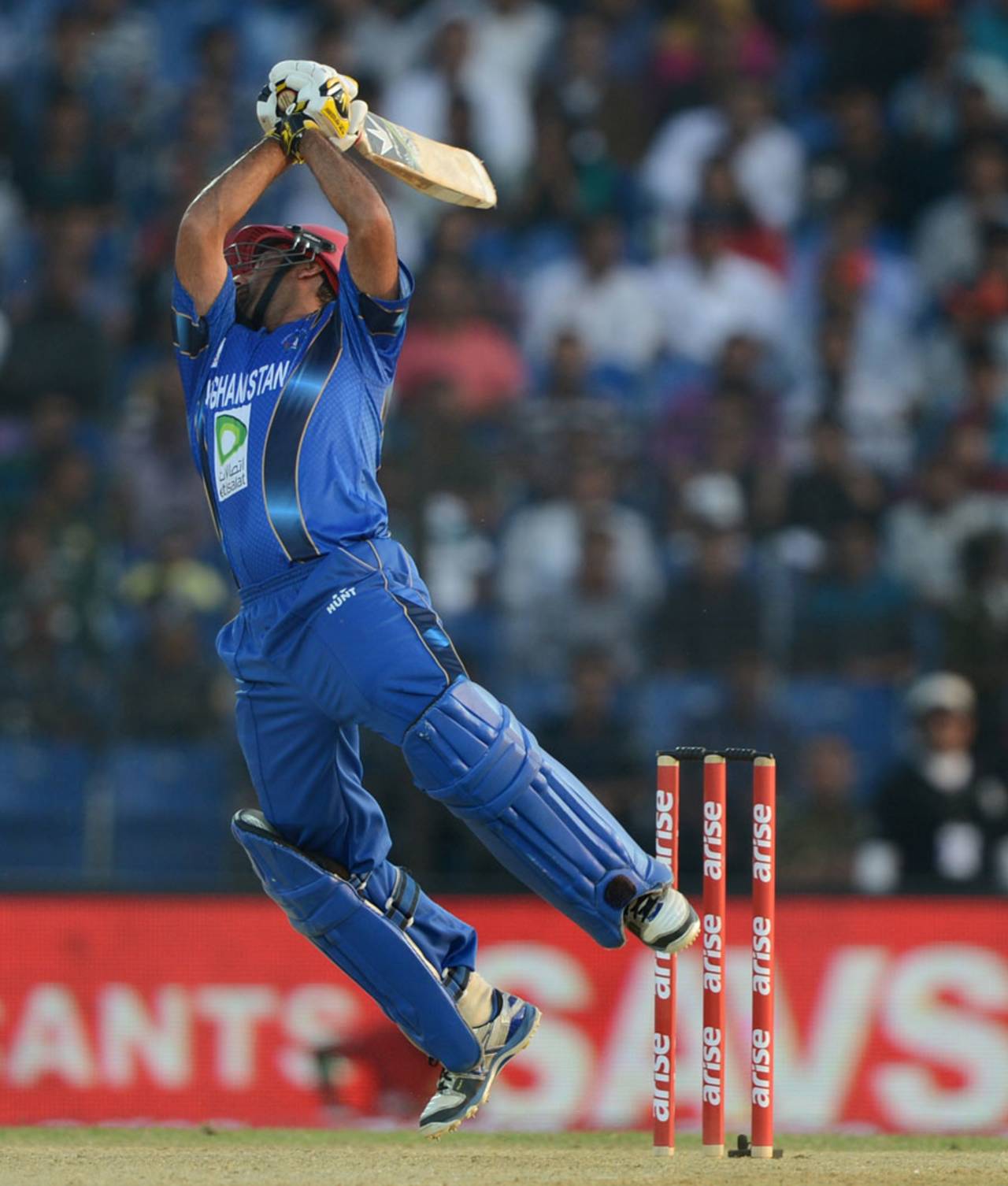Stanikzai and Shenwari engineer expert escape
Afghanistan's dramatic sixth-wicket partnership, particularly Asghar Stanikzai's innings, was a window into the mentality of Associate cricketers; the concept of going for broke against a top side is no longer considered the only route to success
Mohammad Isam in Fatullah
01-Mar-2014

Asghar Stanikzai began cautiously and then exploded in what was a well-paced ODI innings • AFP
Against Bangladesh, Asghar Stanikzai and Samiullah Shenwari played the sort of innings that reminds you that international cricket still has some folklore left in it, amid all the excess and frills. In real world terms, these two innings speak of how far and deep cricket can go in the world and what it can come to mean, even to countries that have embraced it not so long ago.
The Stanikzai-Shenwari partnership - 164 in 138 balls for the sixth wicket - turned Afghanistan's innings at one go into launch pad and fortress, and set up the Asia Cup's most magical match till now. The pair battled hard when the team needed it; just when Afghanistan looked to be giving it away, the pair conjured up a stunning final ten overs. It happens to be the best sixth-wicket partnership among Associate nations. That categorisation however didn't matter; Stanikzai-Shenwari tackled the situation with the chutzpah of hardened competitors.
This Saturday in Fatullah will always be remembered by Afghanistan's cricket team and its tens of thousands of fans. For world cricket, it was a match to cause reflection. The fact that cricket is not the sport for underdogs is quite obvious these days. Afghanistan and their cricket, though, have always brought surprise and joy. And on Saturday afternoon, this batting pair provided reason to believe that cricket can still be followed in a different way; by watching unknown batsmen bat, and finding out more and more about them until you turn into a fan.
This dramatic sixth-wicket partnership, particularly Stanikzai's innings, became a window into the mentality of Associate cricketers; the concept of going for broke against an international side is no longer considered the only route to success. It could be the effect of the considerable number of longer-version matches that Afghanistan and their fellow Associates get to play these days. While Stanikzai's was a display of this mindset, Shenwari's innings wasn't just a Sunday hit-out either. He hardly hit anything that looked out of place at the top level during his chanceless knock. Technically Shenwari's 81 was highly competent.
These two innings, in terms of impact, could be compared with Kevin O'Brien's 113 against England in the 2011 World Cup or John Davison's 111 against West Indies in the 2003 World Cup. Shenwari would stand toe-to-toe with Davison or O'Brien for his hitting, but Stanikzai's unbeaten 90 was a superbly-paced innings and should get all the plaudits. He beat his previous highest, 66, against Australia - also Afghanistan's highest against Test-playing nations. In this instance, he first had to ensure his team's total gained respectability before squeezing enough to put pressure on Bangladesh. It took him 73 balls to get to 37, during which time he had ensured Afghanistan had touched 150 in the 41st over.
From that point onwards, Stanikzai helped his team to 100 more runs in nine overs. His contribution was 53 off the next 30 balls, during which he hit all his boundaries - six fours and three sixes. Shenwari was the free scoring batsman in the partnership until Stanikzai decided to step into turbo mode.
Afghanistan had created a chance for themselves in their previous match, against Pakistan, before Umar Akmal's century. It was Shenwari who had dropped him in that game. On Saturday, he left a far better imprint on the game. He was in many ways the engine driver of the match-turning partnership, aggressor from the start. He had come in to bat 90 for 5, found the off-side gaps more often than Stanikzai, and when the need arose for big hits, Afghanistan had their next best thing to Mohammad Nabi.
When Nabi fell in the 27th over, the fifth man out, Afghanistan were hanging by a thread. With their last recognised pair in the middle, there had to be a lot of patience and perseverance. Stanikzai, who a reputation of being a battler in the worst of times, was the man who understood that. He had apparently taken some criticism back home for batting slowly against Pakistan; he made 40 off 91 balls against one of the more highly-rated bowling attacks in the world. Here, he started slowly again, but then accelerated at the right time. The dramatic acceleration took everyone by surprise. One would claim that he had been helped by Imrul Kayes' two dropped catches in consecutive overs, but that was when he had already got to 72 and 77. By the time he got those lives, he had proved his worth as a batsman.
In late November last year, Stanikzai left Fatullah with a second-ball duck. It was his final innings for Mohammedan Sporting Club in the Dhaka Premier League, and he must have wondered at the time if he would play on Bangladesh's domestic cricket circuit again. With this unbeaten 90, he has set right his reputation in Bangladesh and, with Shenwari, shown that the tournament's underdog can do more than challenge.
Mohammad Isam is ESPNcricinfo's Bangladesh correspondent. He tweets here